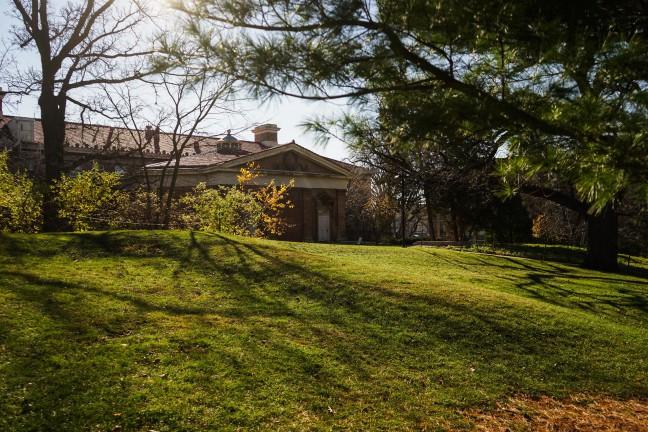The home of thousands of Native American effigy mounds, some as ancient as 2,000 years old, Madison has played a fascinating role in the story of the state and the University of Wisconsin campus.
Madison’s ‘Lost City’: Inside the forgotten remains of Lake Forest
Ancient history of the mounds
Scattered across Wisconsin, effigy mounds are fragments of an ancient culture spanning from about 400 to 1200 AD. To the unobservant eye, they only appear to be elevated land. But the mounds are what archeologists believe to be Native American burial sites, shaped like spirits or animals and functionally placed.
Experts have identified the natives responsible for these mounds as, simply put, effigy mound builders of the woodlands people. They thrived on Madison’s ancient oak savannah, which has long since been replaced with the trees and woods on both the UW Lakeshore campus and at the UW Arboretum.
“I reimagine this landscape prior to it being radically transformed to this American campus that we consider one of the most beautiful campuses in America,” Aaron Bird Bear, School of Education’s interim assistant dean and director, said. “But I remind us that it’s been transformed and it had a different beauty and a different function for a different society just a short 180 years ago.”
Destruction to preservation
On the drumlin, or glacial hill, we now know as Observatory Hill, a bird mound with a 109-foot wingspan and water spirit mark the existence of the ancient woodlands people. Agriculture Hall, North Hall and Bascom Hall have buried more mounds beneath their foundations, but this occurred before the institution of protection laws.
“Basically the mounds can’t be destroyed,” Molly Fifield Murray, UW Arboretum outreach programs manager, said. “If you’re building something or have a trail, it needs to be 25 feet away from a known mound.”
In addition, the Native American Graves Protection and Repatriation Act of 1990 enforces stricter consequences for disturbing the mounds, such as fines and potential imprisonment.
Accepted by the Board of Regents in 1932 with federal wildlife protection funds, the UW Arboretum land belongs to the university and cannot be sold.
“There are numerous parts of the Arboretum that have been designated archaeological sites — they were investigated first by Charles Brown,” Murray said. “He was the head of the Wisconsin Historical Society at the time in the early 1900s and he investigated the number of mounds throughout the state.”
While other earthen mounds of various cultures exist in the U.S., no other place in the country can boast about effigy mounds like the ones found in Wisconsin, particularly in Madison. Through the late 1800s and early 1900s, people endeavored to investigate these products of ancient native society.
Despite the serious preservation efforts in Wisconsin today, many effigy mounds have been lost in the expansion of urban settlement.
“There were amazing mounds in Madison,” Murray said. “In between Lake Wingra and Lake Monona, there was a hill — it was called the dividing ridge. It was six stories high … On top of that [were] a couple dozen effigy mounds that were spectacular … Two different gravel companies purchased the land, took down the ridge and filled in around Lake Monona to build more city.”
Federal protection laws came into effect too late for another colossal effigy mound, spanning roughly three-fourths of a mile and 40 feet high. Though settlers bulldozed this majestic showcase of antiquity for what we now call downtown Madison, a segment of that mound remains today.
In light of past atrocities, the university is seeking further recognition for historical pieces of land.
“We are pursuing a nomination of the Willow Drive mounds so that they can be added to the National Register of Historic Places,” Daniel Einstein, UW historic and cultural resource manager, said. “In the course of that, the preparation of that nomination, there was a new look taken at the historic record.”
Significance
Despite such an abundance of rich history, historians are still searching for answers regarding the true significance of these effigy mounds. But general theory suggests them to be ancient ceremonial and social sites, particularly where human burials occurred. Varying shapes of the mounds potentially represented leaders and their roles within clan systems.
The discoverable truth may have been lost to the general public, but there remains knowledge and information among the Ho-Chunk community. They have yet to disclose it.
“They’re not certain how this knowledge will be used because up until 1974, their languages and cultures were criminalized and banned until the Indian Self-Determination Education Assistance Act,” Bird Bear said.
Regardless of what we don’t know, there is no question our campus is truly a magnificent stretch of culture.
“It’s why we’re the most archaeologically rich campus — we just have 12,000 years of humanity in this very resource-rich space,” said Bird Bear. “Then in particular, we’re the center of this society that flourished for 1800 years in this particular spot before the Americans arrived.”
This chapter of our land’s history forces us to face our past, which inevitably draws up conflict.
“We’re concerned more about what innovation keeps going forward, and we don’t really interrogate the past and think about how long humans have really been here,” Bird Bear said. “Globalization is forcing us to think about our own, full human history because we’re confronting people who have deeper histories in more sincere and connected ways.”














